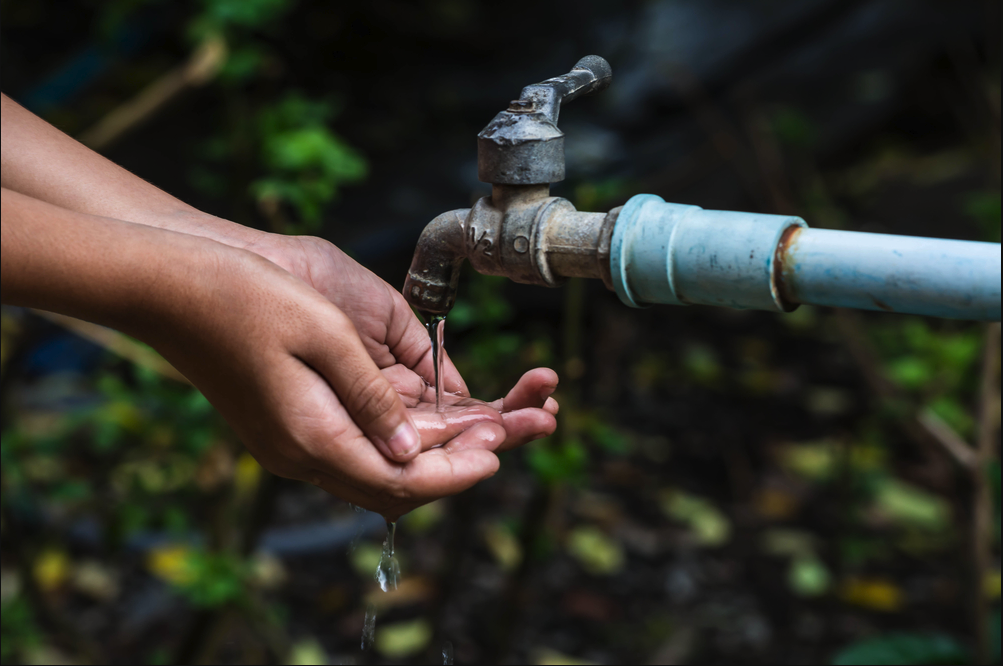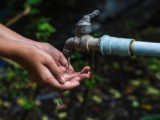Staff Report –
WASHINGTON, D.C. — While the nations of the world gather in Dubai for the 28th United Nations Climate Change Conference, the Biden administration announced a comprehensive plan to replace all water pipes in the United States that contain the harmful pollutant lead.
The Environmental Protection Agency announced a proposal on Thursday to strengthen its Lead and Copper Rule that would require water systems across the country to replace lead service lines within 10 years. Lead is a neurotoxin that can cause irreversible damage to the nervous system and the brain. It poses a particular danger to infants and children and can impair their cognitive development, cause behavioral disorders and lead to lower IQs. From the nation’s earliest days, lead was used to make pipes to carry water to homes and businesses. But when plumbing corrodes, lead can leach into drinking water.
EPA is also proposing additional improvements to protect public health, such as lowering the lead action level and improving sampling protocols utilized by water systems. The action advances President Joe Biden’s commitment to remove every lead service line in America “to protect children and vulnerable populations from the negative impacts of lead in drinking water, particularly those living in disadvantaged communities.”
“Lead in drinking water is a generational public health issue, and EPA’s proposal will accelerate progress towards President Biden’s goal of replacing every lead pipe across America once and for all,” EPA Administrator Michael S. Regan said in making the announcement. “With collaboration and the focused actions proposed today, EPA is delivering on our charge to protect all Americans, especially communities of color, that are disproportionately harmed by lead in drinking water systems.”
The administration is using every tool available to help communities and water systems “Get the Lead Out” according to the announcement, including investing a historic $15 billion through the Bipartisan Infrastructure Law to replace lead service lines, providing technical assistance to communities, and supporting the development of a national inventory of lead service lines.
“EPA’s proposed Lead and Copper rule is grounded in the best available science and successful practices utilized by drinking water systems to protect children and adults from lead in drinking water,” said EPA Assistant Administrator for Water Radhika Fox. “Cities like Newark, NJ, Benton Harbor, MI, and Green Bay, WI have all successfully gotten the lead out of their water systems. Our proposed rule applies the lessons learned to scale these successes to every corner of the country.”
The science is clear: there is no safe level of lead exposure. In children, it can severely harm mental and physical development — slowing down learning and damaging the brain. In adults, lead can cause increased blood pressure, heart disease, decreased kidney function and cancer.
The proposal would not eliminate the amount of lead permitted in drinking water. Instead, the Biden administration wants to lower the allowable amount to 10 parts per billion from the current 15 parts per billion. That’s disappointing to many public health advocates, who have called for a standard between zero and five parts per billion. Scientists agree there is no safe level of lead in drinking water.
The proposed Lead and Copper Rule Improvements are a major advancement in protecting children and adults from these significant, and irreversible, health effects from lead in drinking water. Key provisions in the proposal include:
* Achieving 100% Lead Pipe Replacement within 10 years.
* Locating legacy lead pipes.
* Improving tap sampling.
* Lowering the Lead Action Level.
* Strengthening protections to reduce exposure.
The proposal would also require water systems to communicate more frequently and proactively with consumers about lead service lines and the system’s plans for replacing the lines.
“President Biden and Vice President Harris believe that everyone should be able to turn on the tap and know that the glass of water they pour is safe to drink,” said White House Council on Environmental Quality Chair Brenda Mallory. “Today’s announcement from EPA represents a major advancement in protecting children and families from lead and builds on our actions across the government to help achieve President Biden and Vice President Harris’s vision of removing all lead pipes across the country.”
Once the proposed rule is published in the Federal Register, EPA will accept comments for 60 days. The agency will also hold a virtual public hearing on January 16, 2024, when the public will be invited to provide EPA with verbal comments.
“President Biden and Vice President Harris believe that no family, no child, no American should have to worry about lead exposure – from the water they drink or air they breathe,” said Assistant to the President and White House National Climate Advisor Ali Zaidi. “That’s why the President and Vice President have made replacing every lead pipe in America a centerpiece of their agenda, mobilizing tens of billions of dollars of investment and putting the full throw-weight of the federal government behind this push. EPA’s latest action bolsters this historic effort and implements a key element of the Biden-Harris Lead Pipe and Paint Action Plan – more than 10 agencies stepping forward with dozens of bold actions to take on and tackle this public health crisis and this staggering source of environmental injustice.”
Mona Hanna-Attisha, Flint, Michigan pediatrician and Associate Dean for Public Health at Michigan State University College of Human Medicine, called the proposal “a game changer for kids and communities.”
“EPA’s proposed new lead and copper rule would help ensure that we will never again see the preventable tragedy of a city, or a child, poisoned by their pipes,” she said.” I am thrilled that this rule centers our children and their potential – and listens to parents and pediatricians who have been advocating for this for decades.”
“Here in Newark, New Jersey, our community persevered through a lead crisis and I’m proud of the work we did removing all 23,000 lead pipes in the city in under three years,” said Kareem Adeem, Director of the Newark Department of Water and Sewer Utilities. “EPA’s new proposed rule will prompt more communities across the country to reduce exposure to lead in drinking water. This action is commendable and represents a positive step forward toward safeguarding the health and well-being of current and future generations.”
For more information about the proposed rule, including a pre-publication version of the proposal, fact sheets, and directions for submitting comment and registering for the public hearing, visit the proposed rule webpage.
Funding
The Bipartisan Infrastructure Law provides $50 billion to support upgrades to the nation’s drinking water and wastewater infrastructure. This includes $15 billion dedicated to lead service line replacement and $11.7 billion of general Drinking Water State Revolving Funds that can also be used for lead service line replacement. To date, EPA has awarded over $3.5 billion in funding for lead service line replacement across the country.
Technical Assistance. EPA’s water technical assistance (WaterTA), including the recently launched Get the Lead Out Initiative which will partner with 200 underserved communities nationwide, helps communities identify lead services lines, develop replacement plans, and apply for funding to get the lead out.
Practical Implementation Tools. Through training, tools, webinars, and case studies, EPA provides support to drinking water systems to reduce lead exposure.
“This is the strongest lead rule that the nation has ever seen,” Radhika Fox, the E.P.A.’s assistant administrator for water, said in an interview with the New York Times. “This is historic progress.”
Digging up and replacing lead pipes from coast to coast is no small undertaking. The EPA estimates the price at $20 billion to $30 billion over the course of a decade. The rule would require the nation’s utilities — and most likely their ratepayers — to absorb most of that cost, but $15 billion is available from the 2021 infrastructure law to help them pay for it.
Tom Dobbins, the chief executive of the Association of Metropolitan Water Agencies, said his members would need both technical help and more financial assistance from the federal government to comply with the proposed regulations. He urged the E.P.A. to “focus on providing drinking water systems with the resources and tools necessary to achieve this ambitious goal, and working toward eliminating the real barriers that exist for many utilities.”
In a statement, the association said it had repeatedly called attention to a long list of obstacles that make it difficult to replace lead pipes, including rising costs, supply chain problems, labor shortages and incomplete or missing building records.
The problem drew national attention in 2014 in Flint, when a change in the water source and inadequate treatment and testing caused significant lead contamination. Lead and Legionella bacteria leached into the tap water of about 100,000 residents between 2014 and 2015.
Lead levels in drinking water also soared in 2019 in Newark, where Yvette Jordan is a high school teacher. “Forty percent of our students are special needs,” she said. “All of these effects we see in our classroom every single day.”
The EPA estimates that its proposal would generate $9.8 billion to $34.8 billion in economic benefits each year, in the form of less cognitive impairment and fewer health disorders, especially in children.
“We have failed generations of children by not eliminating lead,” said Mona Hanna-Attisha, the Michigan pediatrician whose research helped to exposed the 2014 Flint water crisis. “When you have a poison that has no safe levels at all in our drinking water, it makes it impossible to make sure that the future of our nation is successful.”
She said she was frustrated that the allowable level wasn’t closer to zero but said lowering it would be “a good thing.”
“To finally have a rule that mandates the removal of lead pipes is exactly what the government should be doing,” Dr. Hanna-Attisha said.
The proposal, which would update regulations under the 1991 Safe Drinking Water Act, is the most forceful part of a multifront push by President Biden to stop lead exposure. Biden has made it a central part of his administration’s effort to address racial health disparities in the United States. Children in communities of color and in low-income urban areas are more likely to be exposed to lead from paint and aging water systems than their counterparts in areas with new housing and infrastructure.
“The vice president and I made a commitment to replace every single service line in every part of the country over the next decade, by using — not most, every — we’re using every tool at our disposal to get it done,” Biden said in a February speech about his lead abatement initiatives.
In the wake of the Flint crisis, the Trump administration required schools and day care centers to test for lead in their drinking water and ordered water utilities to conduct inventories of their lead service pipes and publicly report their locations. But the administration also doubled, to 30 years, the amount of time that utilities could take to replace lead pipes.
Under the EPA’s proposal announced Thursday, utilities must eliminate lead pipes over the next 10 years at a pace of 10 percent each year. They would also be required to create inventories of all their lead pipes.
While the rule would compel water utilities to bear the cost of the undertaking, it has a major loophole: It does not require them to pay for the replacement of the smaller portion of lead lines that are on private property. Federal officials made access to the $15 billion in the infrastructure law for lead pipe replacement conditional on utilities’ replacing the entire lead water pipe, including portions on private property.
Fox said that states and municipalities had the authority to compel local water utilities to absorb the entire cost of replacing lead pipes, including those on private property. She pointed to Newark and Washington, D.C., as cities that had already done so. In 2004, a jump in lead levels in the water in Washington was followed by a fourfold increase in the levels of lead in the blood of some children there.
The E.P.A. will accept public comments on the proposal for 60 days and could still make changes to it before making it final sometime next year.
___
If you support truth in reporting with no paywall, and fearless writing with no popup ads or sponsored content, consider making a contribution today with GoFundMe or Patreon or PayPal. We just tell it like it is, no sensational clickbait or pretentious BS.














